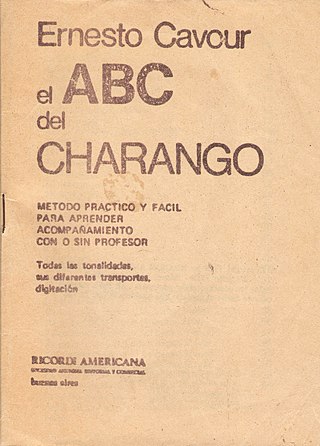Related Research Articles
Alternative country is a loosely defined subgenre of country music and/or country rock that includes acts that differ significantly in style from mainstream country music, mainstream country rock, and country pop. Alternative country artists are often influenced by alternative rock. Most frequently, the term has been used to describe certain country music and country rock bands and artists that are also defined as or have incorporated influences from alternative rock, indie rock, punk rock, heartland rock, Southern rock, progressive country, outlaw country, neotraditional country, Texas country, Red Dirt, roots rock, indie folk, folk rock, rockabilly, bluegrass, and honky tonk.
The music of Bolivia has a long history. Out of all the Andean countries, Bolivia remains perhaps the most culturally linked to the indigenous peoples.
Los Jairas was a Bolivian folk music group that was active in the 1960s. Their work features the charango, a stringed instrument from Bolivia.
Post-punk revival is a genre or movement of indie rock that emerged in the early 2000s as musicians started to play a stripped down and back-to-basics version of guitar rock inspired by the original sounds and aesthetics of post-punk, new wave and garage rock. It is closely associated with new wave revival and garage rock revival.
Paja Brava is a Bolivian musical group. The band has had many different musicians that have participated over the years. The first recording was a self-titled album released in 1977 .
Elvy Sukaesih is an Indonesian dangdut singer who has been dubbed the Queen of Dangdut. Sukaesih has a significant fan base in other Asian countries such as Japan. She has been a prolific recording artist since the late 1960s.
This is a list of folk music traditions, with styles, dances, instruments, and other related topics. The term folk music cannot be easily defined in a precise manner. It is used with widely varying definitions depending on the author, intended audience and context within a work. Similarly, the term traditions in this context does not connote any strictly-defined criteria. Music scholars, journalists, audiences, record industry individuals, politicians, nationalists, and demagogues may often have occasion to address which fields of folk music are distinct traditions based along racial, geographic, linguistic, religious, tribal, or ethnic lines, and all such peoples will likely use different criteria to decide what constitutes a "folk music tradition". This list uses the same general categories used by mainstream, primarily English-language, scholarly sources, as determined by relevant statements of fact and the internal structure of works.

The Bolivian Palace of Government, better known as Palacio Quemado, was the official residence of the President of Bolivia from 1853 to 2018 and again briefly from 2019 to 2020. It is located in downtown La Paz on Plaza Murillo, next to the La Paz Cathedral and across from the Bolivian legislature. On 9 August 2018, it was replaced by the Casa Grande del Pueblo as the residence of the president by President Evo Morales. The interim government of Jeanine Áñez briefly reverted to occupying the Palacio Quemado from 2019 until 2020 when the newly elected Luis Arce returned to using the Casa Grande. It now serves as a museum.
Savia Andina is an Andean folk music ensemble from Bolivia, and it was founded in 1975. The group originated in 1964 as schoolmates Gerardo Arias, Eddy Navia and Oscar Castro formed the rock band "Los Rebeldes" in the city of Potosí. Following some records by Arias and Navia in Argentina in the early 1970's they invited Castro back and others to officially form Savia Andina on July, 1975. Savia Andina was one of the first groups to have international success with traditional Andean music. They had this success starting in the 1960s and went on to have three albums to go gold. They toured Europe and are sometimes classed in the "new song/nueva cancion" movement of Latin American music. In the 1970s they became the most popular and influential music group in Bolivia, but were later displaced by Los Kjarkas. They are also known for poetic love songs about mountains. Eddy Navia, a founder of the group noted as a charango player, left in 1988 to join Sukay.
William Dillard was an American jazz trumpeter, actor, and singer.

Tambomachay is an archaeological site associated with the Inca Empire, located near Cusco, Peru. An alternate Spanish name is El Baño del Inca.

The Rough Guide to the Music of the Andes is a world music compilation album originally released in 1996. Part of the World Music Network Rough Guides series, the album features the music of the Andes Mountains of South America, focusing especially on the music of Bolivia, whose musicians contributed eleven tracks. Also featured is Peru and Chile. The compilation was produced by Phil Stanton, co-founder of the World Music Network.

Ernesto Cavour Aramayo was a Bolivian singer, musician, inventor of musical instruments, and author of Bolivian music teaching books. He was a founding member of the group Los Jairas.
References
- ↑ McConnachie, James (2000). World music: the rough guide, Volume 2. Rough Guides. p. 276. ISBN 978-1-85828-636-5.
- ↑ Baumann, Max Peter (2001). "Bolivia: Traditional music". Oxford Music Online. Oxford University Press. p. 12. doi:10.1093/omo/9781561592630.013.60000200231.
- ↑ Leichtman, Ellen (1989). "Musical Interaction: A Bolivian Mestizo Perspective". Latin American Music Review / Revista de Música Latinoamericana. 10 (1): 33. doi:10.2307/780381. ISSN 0163-0350. JSTOR 780381.